Articles
- Page Path
- HOME > J Korean Acad Nurs > Volume 39(2); 2009 > Article
-
Original Article
- Development of a Breast Feeding Adaptation Scale (BFAS)
- Sun Hee Kim
-
Journal of Korean Academy of Nursing 2009;39(2):259-269.
DOI: https://doi.org/10.4040/jkan.2009.39.2.259
Published online: April 28, 2009
Part-time Lecturer, Department of Nursing Science, Ewha Womans University, Seoul, Korea.
- Address reprint requests to: Kim, Sun Hee. Department of Nursing Science, Ewha Womans University, 11-1 Daehyeon-dong, Seodaemun-gu, Seoul 120-750, Korea. Tel: 82-2-3277-2875, Fax: 82-2-3277-2850, carpesun@hanmail.net
Copyright © 2009 Korean Society of Nursing Science
Abstract
-
Purpose
- The aim of this study was to develop a breast feeding adaptation scale (BFAS) to evaluate adaptation to breastfeeding for breastfeeding mothers and their infants and to test the validity and reliability of the instrument.
-
Methods
- The study was conducted as follows: application of the conceptual framework, identification of the content domains, items generation, and test of validity and reliability. In order to test validity and reliability, two panels of experts reviewed items and subcategories of the preliminary questionnaire and then data were collected from 329 mothers who were up to 4 weeks postpartum and breastfeeding. Descriptive statistics, t-test, factor analysis, and Cronbach's alpha were used to analyze the data.
-
Results
- The conceptual framework was based on the Roy adaptation model. The content domains were developed via literature review, review of instruments, and data acquired from the interviews of breastfeeding mothers and nurses. A total of 69 items belonging to 8 domains were generated. A reduction to 44 preliminary items was accomplished through content validity analysis. Factor analysis extracted 8 factors with a total of 27 items on a 5-point Likert scale. Content validity, construct validity, criterion validity, and reliability of the BFAS were established.
-
Conclusion
- The newly developed BFAS is a reliable and valid instrument with which the adaptation of breastfeeding mothers and their infants to the breastfeeding behavior can be evaluated.
- 1. Academy of Breastfeeding Medicine Korea. New mother's guide to breastfeeding. 2006;Seoul, E*PUBLIC.
- 2. Ahluwalia IB, Morrow B, Hsia J. Why do women stop breastfeeding? Findings from the Pregnancy Risk Assessment and Monitoring System. Pediatrics. 2005;116:1408–1412.ArticlePubMedPDF
- 3. American Academy of Pediatrics (AAP) Section on breastfeeding. Breastfeeding and the use of human milk. Pediatrics. 2005;115:496–506.ArticlePubMedPDF
- 4. Cadwell K, Turner-Maffei C, O'Connor B, Blair AC, Arnold LD, Blair EM. Maternal and infant assessment for breastfeeding and human lactation: A guide for the practitioner. 2006;2nd ed. Sudbury, MA, Jones and Bartlett Publishers.
- 5. Chezem J, Friesen C, Boettcher J. Breastfeeding knowledge, breastfeeding confidence, and infant feeding plans: Effects on actual feeding practices. Journal of Obstetric, Gynecologic, and Neonatal Nursing. 2003;32:40–47.Article
- 6. Dennis CL. Breastfeeding initiation and duration: A 1990-2000 literature review. Journal of Obstetric, Gynecologic, and Neonatal Nursing. 2002;31:12–32.Article
- 7. Dennis CL, Faux S. Development and psychometric testing of the breastfeeding self-efficacy scale. Research in Nursing & Health. 1999;22:399–409.Article
- 8. Hill PD, Humenick SS. Development of the H & H Lactation Scale. Nursing Research. 1996;45:136–140.ArticlePubMed
- 9. Huggins K, Ziedrich L. The nursing mother's guide to weaning. 2007;Boston, MA, The Harvard Common Press.
- 10. Clinical guidelines for the establishment of exclusive breastfeeding. International Lactation Consultant Association (ILCA). 2005;06;Retrieved June 20, 2007. from http://www.ilca.org/ClinicalGuidelines2005.pdf.
- 11. Isabella PH, Isabella RA. Correlates of successful breastfeeding: A study of social personal factor. Journal of Human Lactation. 1994;10:257–264.PubMed
- 12. Jeong GH. Effects of the nursing intervention program on promoting the breastfeeding practice in primipara. 1997;Seoul, Ewha Womans University. Unpublished doctoral dissertation.
- 13. Kendall-Tackett K, Sugarman M. The social consequences of long-term breastfeeding. Journal of Human Lactation. 1995;11:179–183.ArticlePubMedPDF
- 14. Kim HS. Potential determinant factors of insufficient milk supply syndrome. Journal of Korean Academy of Nursing. 1994;24:33–46.ArticlePDF
- 15. Kim HS. Analysis of the content of telephone counseling with breastfeeding mothers. Journal of Korean Academy of Nursing. 1995;25:17–29.ArticlePDF
- 16. Kim SH. Breastfeeding knowledge and attitude of the female university students. 2001;Seoul, The Catholic University of Korea. Unpublished master's thesis.
- 17. Kim SJ, Yang SJ. A study of primiparous women's breastfeeding experience. Journal of Korean Academy of Nursing. 1997;27:477–488.ArticlePDF
- 18. Kim YM. Effects of breastfeeding empowerment program on exclusive breastfeeding. 2006;Seoul, Seoul National University. Unpublished doctoral dissertation.
- 19. Kong SK, Lee DT. Factors influencing decision to breastfeed. Journal of Advanced Nursing. 2004;46:369–379.ArticlePubMed
- 20. Lawson K, Tulloch MI. Breastfeeding duration: Prenatal intentions and postnatal practices. Journal of Advanced Nursing. 1995;22:841–849.ArticlePubMed
- 21. Lee KH, Park YJ, Byeon SJ, Yu EG, Lee MR, Lee YS, et al. Women's health nusing I. 1998;Seoul, HyeonMoonSa.
- 22. Lee SO, Chung ES, Ahn SH, Moon GN, Park NH. A study of predictors of breastfeeding. Korean Journal of Child Health Nursing. 2003;9:368–375.
- 23. Lee YS, Im HS, Ahn HS, Jang NS. Nutrition throughout the life cycle. 2006;2nd ed.Paju, KyoMunSa.
- 24. Leff EW, Jeffereis SC, Gagne MP. The development of the Maternal Breastfeeding Evaluation Scale. Journal of Human Lactation. 1994;10:105–111.ArticlePubMedPDF
- 25. 2005 Korean national health and nutrition survey: Nutrition survey. Ministry of Health and Welfare. 2006;07 05 Retrieved October 12, 2007. from http://www.mw.go.kr/front/al/sal0301vw.jsp?.
- 26. Moran VH, Dinwoodie K, Bramwell R, Dykes F. A critical analysis of the content of the tools that measure breast-feeding interaction. Midwifery. 2000;16:260–268.ArticlePubMed
- 27. Punthmatharith B, Singh J. A psychometric assessment of the H & H lactation scale in a sample of Thai mothers using a repeated measurement design. Nursing Research. 2005;54:313–323.ArticlePubMed
- 28. Roy SC, Andrews HA. The Roy adaptation model. 1999;2nd ed. Stamford, CT, Appleton & Lange.
- 29. Streiner DL, Norman GR. Health measurement scales: A practical guide to their development and use. 2003;3rd ed. New York, NY, Oxford University Press.
- 30. Tinsley HE, Tinsley DJ. DeVellis RF. Uses of factor analysis in counseling psychology research. In: Scale development: Theory and applications. 1987;Thousand Oaks, CA, Sage Publications. 137.
REFERENCES
Figure & Data
REFERENCES
Citations

- Development of Maternal Adaptation Scale for the Primipara Women
Jungmi Ko, Ju-Eun Song
Journal of Korean Maternal and Child Health.2024; 28(2): 51. CrossRef - Emzirme Adaptasyon Ölçeği Türkçe Geçerlik ve Güvenirlik Çalışması
Yasemin DİNÇEL, Resmiye ÖZDİLEK
Bandırma Onyedi Eylül Üniversitesi Sağlık Bilimleri ve Araştırmaları Dergisi.2021; 3(3): 190. CrossRef - Breastfeeding Adaptation Scale-Short Form for mothers at 2 weeks postpartum: construct validity, reliability, and measurement invariance
Sun-Hee Kim
Korean Journal of Women Health Nursing.2020; 26(4): 326. CrossRef - Effects of Breast-Feeding Adaptation and Quality of Sleep on Postpartum Depression in Puerperal Women
Chae Yeon Lee, Hun Ha Cho
Journal of The Korean Society of Maternal and Child Health.2019; 23(3): 162. CrossRef - Factors associated with Maternal Attachment of Breastfeeding Mothers
Sun-Hee Kim
Child Health Nursing Research.2019; 25(1): 65. CrossRef - Impact of Parenting Stress and Husband's Support on Breastfeeding Adaptation among Breastfeeding Mothers
Seung Hui Heo, Yoon Goo Noh
Korean Journal of Women Health Nursing.2017; 23(4): 233. CrossRef - Effects of Breastfeeding Empowerment Program on Breastfeeding Self-efficacy, Adaptation and Continuation in Primiparous Women
Seon Mi Song, Mi Kyung Park
Journal of Korean Academy of Nursing.2016; 46(3): 409. CrossRef - Development of a Breastfeeding Effectiveness Scale (BES)
Hyun-Joo Yang, Min-Young Jeong, Ji-Min Seo
Korean Journal of Women Health Nursing.2016; 22(4): 264. CrossRef - Association of Parenting Stresses, Maternal Role Adjustment, and Types of Feeding during Hospital Stays at Birth to Breastfeeding Adaptation
Sukhee Ahn, Yunmi Kim
Korean Journal of Women Health Nursing.2015; 21(4): 262. CrossRef - Maternal Psychosocial Factors that Affect Breastfeeding Adaptation and Immune Substances in Human Milk
Eun Sook Kim, Mi Jo Jeong, Sue Kim, Hyun-A Shin, Hyang Kyu Lee, Kayoung Shin, Jee Hee Han
Korean Journal of Women Health Nursing.2014; 20(1): 14. CrossRef - Brestfeeding Rate and Its Related Factors In Rural area
Hyun-Jee Kim, Keon-Yeop Kim, Jeong-Yeon Hwangbo
Journal of the Korea Academia-Industrial cooperation Society.2014; 15(3): 1671. CrossRef - Comparison of Lactation Problems, Knowledge, and Adaptation on Breastfeeding between Users and Non-Users of Lactation Clinic
Myoung Hee Yun, Hye Sook Shin
Journal of East-West Nursing Research.2014; 20(2): 112. CrossRef - Effects of Breast-feeding Adaptation, Attitude and Practice of Primipara Depending on Method of Postpartum Breast-feeding Education
Seung Eun Yun, Hyea Kyung Lee
Korean Journal of Women Health Nursing.2012; 18(2): 75. CrossRef - Factors Affecting Mother's Adaptation to Breastfeeding
Sun Hee Kim
Journal of Korean Academy of Nursing.2010; 40(2): 225. CrossRef - Effects of Breast-feeding Education and Support Services on Breast-feeding Rates and Infant's Growth
Gun-Ja Jang, Sun-Hee Kim
Journal of Korean Academy of Nursing.2010; 40(2): 277. CrossRef
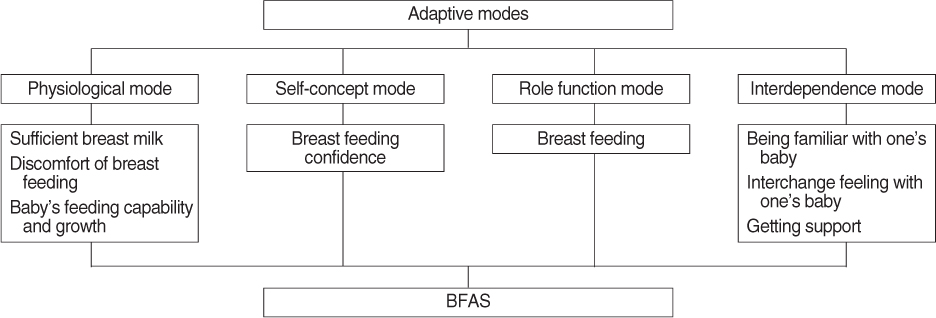
Figure 1
Factor Loading of Each Item of Adaptation to Breastfeeding
Eigenvalue, Explained Variance, Cumulative Variance
Differences of Adaptation to Breastfeeding according to the Present Type of Feeding and the Past Experience of Breast-feeding (N=329)
**p<.01.
Correlation between Subscales of BFAS and Subscales of HHLS (N=329)
*p<.05, **p<.01.
BFAS=breast feeding adaptation scale; HHLS=H & H lactation scale.
Internal reliability of BFAS
BFAS=breast feeding adaptation scale.
**
* BFAS=breast feeding adaptation scale; HHLS=H & H lactation scale.
BFAS=breast feeding adaptation scale.
 KSNS
KSNS
 E-SUBMISSION
E-SUBMISSION

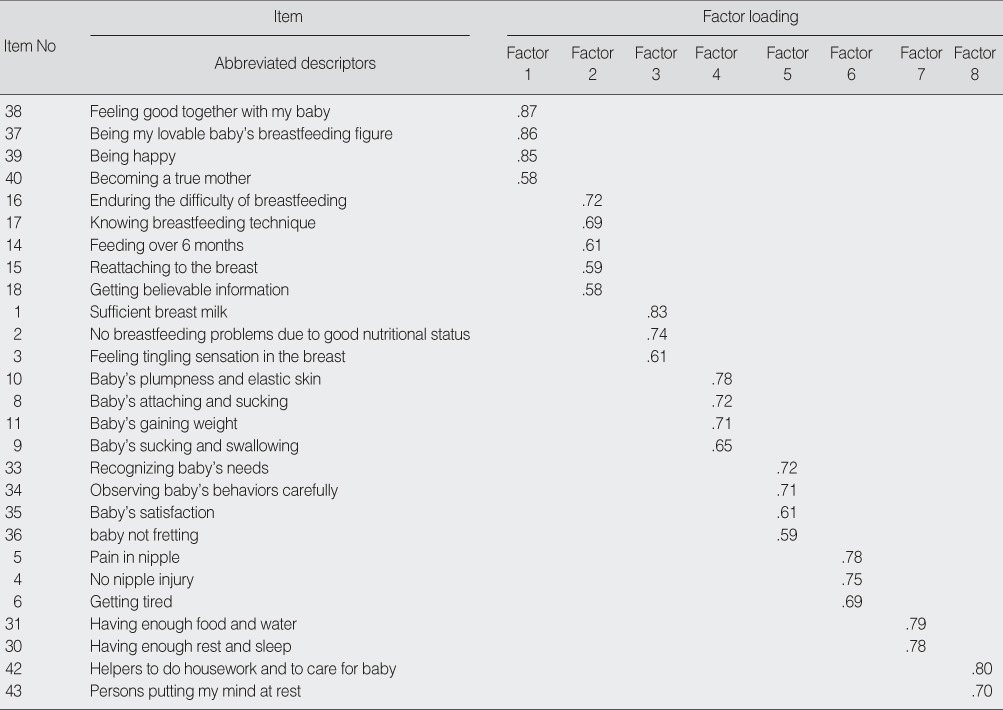
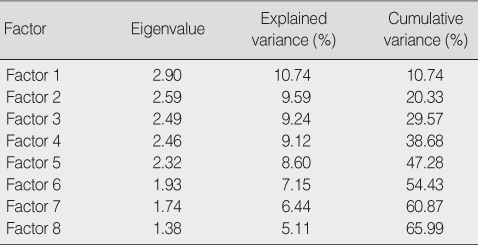

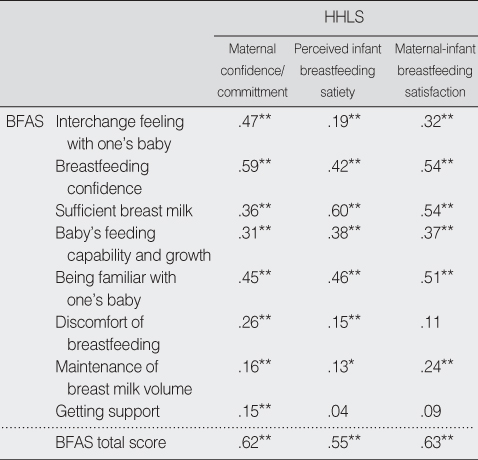
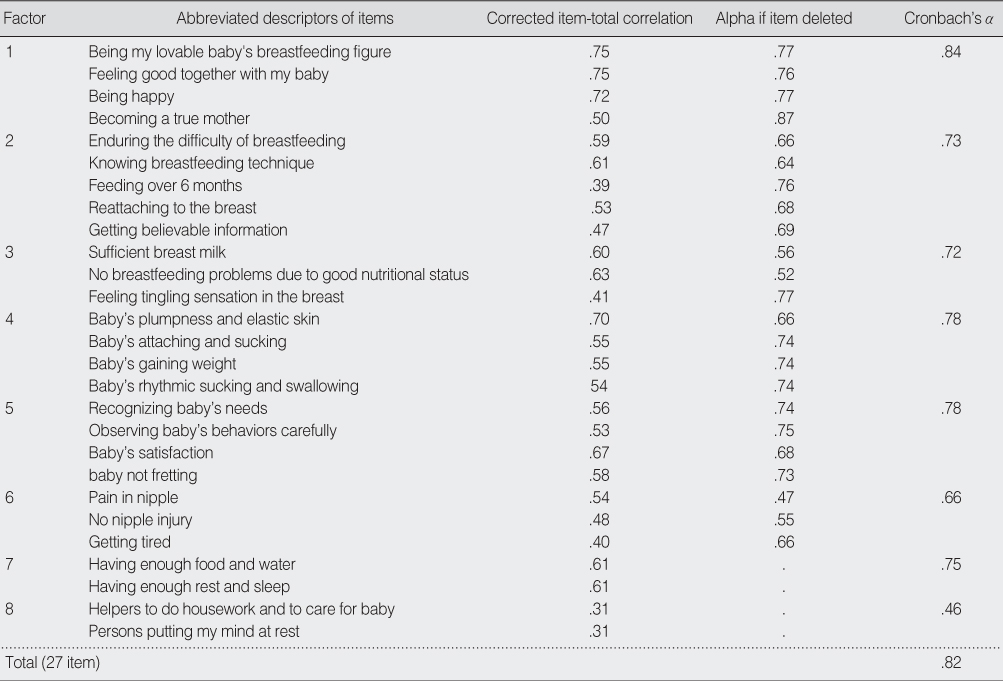
 Cite
Cite

